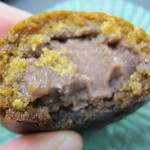
野田饅頭店
Nodamanjuuten
3.04
Omuta Area
「Japanese Sweets」
--
--
Opening hours: Around 8:30 - 19:00
Rest time: First and third Sundays Business hours and holidays are subject to change, so please check with the store before visiting.
福岡県みやま市瀬高町大字下庄2000
Photos
(20)




















Details
Comments
(3)
8823S
3.50
This is a traditional Japanese sweets shop located in Setaka-cho, Miyama City, Fukuoka Prefecture. They sell colorful "Notsuru Manju," which are small and beautiful steamed buns. You can enjoy a variety of colors and they are bite-sized, so you can easily eat them!


喜一郎
4.30
Karinto manju stored in the refrigerator on the third day... when eaten, it's soft and lacks the satisfying crunch it had when fresh. Karinto manju is best enjoyed on the day it's made. Hana mochi stored in the freezer and heated up in the microwave was delicious. A friend from Segata gave me karinto manju and hana mochi. The karinto manju was hard and rustic, with a delicious taste. The hana mochi was soft and had a great texture. It's a specialty of Segata, the hometown of the famous politician Makoto Koga. This year, I received hana mochi as a souvenir during the Tanabata season. It's a simple yet beautiful steamed rice cake. It's chewy and delicious, with a subtly sweet red bean paste filling. I don't see hana mochi often in Kurume, so it was a treat. For today's snack, I enjoyed the karinto manju I had stored in the refrigerator. The crispy skin and tasty filling made it a delightful treat. The hana mochi remained soft even after a day, although it lost some of its bouncy texture. It was still delicious. Noda Manju, famous for its red and white manju in Segata Town, is known for its karinto manju. A friend from Segata gave me hana mochi. In the past, hana mochi used to be sold in batches of 10 or 20 for Tanabata offerings, but now it's a popular tea snack. Karinto manju is a recent new product. It's a deep-fried manju with a black bean paste filling, covered in karinto dough. It's not commonly seen in Kurume. The hana mochi has a stretchy skin and a delicious subtly sweet red bean paste filling. The karinto manju has a crispy skin and a satisfying crunch, with a generous amount of bean paste filling. It's delicious, but not suitable for those with diabetes. Enjoyed it very much.




e-シュン
3.00
The Kanto region is experiencing unseasonable snow, while Kyushu is enjoying a spring-like atmosphere. I went for a walk, drawn by the warm weather, and visited the Miyama City (formerly Segata Town) Shimizu Mountain Peony Garden. The garden was filled with colorful peonies in full bloom, attracting a large crowd of visitors. On the way to the garden by bus from Segata Station, I noticed the Noda Manju Store through the window. I have a habit of not being able to pass by such casual Japanese sweet shops, so naturally, I stopped by on my way back. Inside the store, there were various manju and sweets on display, but I decided to buy the manju with the store's signature crane logo and the simple-looking honey manju. As for the taste, the Crane Manju (65 yen) had slightly dry skin and lacked moisture. The flavor was nothing special, and there was plenty of red bean paste inside. It didn't stand out as a unique manju. The Honey Manju (40 yen) had a crispy skin with white bean paste inside, similar to the Komokumanju from Omuta. The price per piece was the same as Komokumanju, but the sweetness of the bean paste was quite strong. It's the type of sweet where you might not be able to stop eating once you start, but after 1-2 pieces, you might feel satisfied. It could be a good match with a bitter green tea when you want just a little bit of sweetness.




Email Login